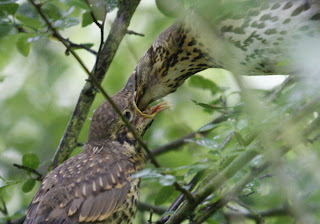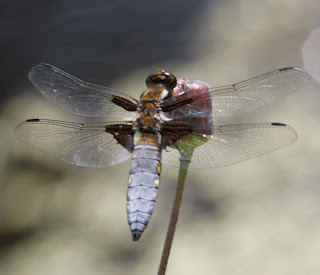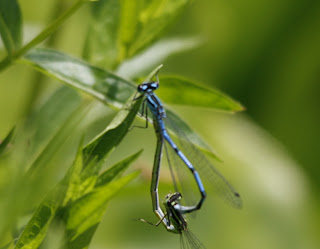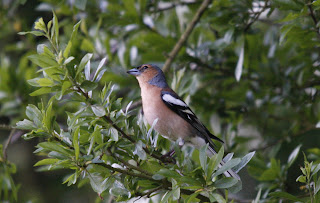Back home Goldfinch in garden on feeder. The hedgehog is still visiting (is it me or is she thinner?)
6th Fledgling starlings in the garden while the blue tits and great tits are working hard collecting food for their young. Damselfly butterfly and ladybird briefly in the garden.
8th |First fledgling blue tit in garden -beautiful .
10th The young starling thinks the bird table belongs to him. That is until the adults arrive. The hedgehog is feeding around 10pm and comes right down the steps to the door , scaring a frog on the way.
18th Lot's of noisy sparrow fledglings being fed in next doors trees.
21st Longest day - very sunny. Saw the mouse on the bird feeder.
22nd Spent an amazing 10mins in the evening with a bat flying over head, the hedgehog near my feet and the mouse at the feeder.
The met office have said it has been the driest first 6 months of the year for 80 years!
Tuesday 22 June 2010
Thursday 3 June 2010
June Shropshire part 3
On a visit to a beautiful garden (with the best chicken sandwiches I've ever tasted) we sat by the large pond and took pictures of the dragonflies.
Broad - bodied chaser (libella depressa). they will take over a small pond or pool defending it fiercely, using the same perches each day.
Common Blue damsel Fly (Enallagma cyathagerm). Spends all year as a larvae before emerging as an adult.
the picture shows a pair mating, making a heart shape with their bodies. The male will then fly the female to the water to deposit the eggs in under water vegetation.. They fly between May - September in over grown gardens.
Broad - bodied chaser (libella depressa). they will take over a small pond or pool defending it fiercely, using the same perches each day.
Common Blue damsel Fly (Enallagma cyathagerm). Spends all year as a larvae before emerging as an adult.
the picture shows a pair mating, making a heart shape with their bodies. The male will then fly the female to the water to deposit the eggs in under water vegetation.. They fly between May - September in over grown gardens.
Wednesday 2 June 2010
June Shropshire part 2
Each morning and at intervals in the day we hear the unmistakable sound of the Buzzards. They soar in the sky screeching, laying claim to the territory they fly over. A magnificent sight. The couple below seem to be flying just for the enjoyment of it and who can blame them. The female is the largest of the two.
Buzzard's ( Buteo Buteo ). Found in wood's, moreland, mountains and sea cliffs. It is the most common of our birds of prey. Usually lays 2-3 eggs. They feed on small animals, carrion, birds, earthworms, caterpillars, lizards and beetles.
I spotted a small bird up in the tree that I've never seen before, it turned out to be a Spotted Fly Catcher.
Spotted Fly Catcher (Muscicapa striata)
"If you scare the flycatcher away, no good luck will come your way."
Visits Britain in May - September. Lays 4-5 green/blue eggs heavily freckled with red/brown. Feeds almost entirely on flying insects, flies, crane flies, butterflies and wasps, but will eat worms and rowan berries.
Buzzard's ( Buteo Buteo ). Found in wood's, moreland, mountains and sea cliffs. It is the most common of our birds of prey. Usually lays 2-3 eggs. They feed on small animals, carrion, birds, earthworms, caterpillars, lizards and beetles.
I spotted a small bird up in the tree that I've never seen before, it turned out to be a Spotted Fly Catcher.
Spotted Fly Catcher (Muscicapa striata)
"If you scare the flycatcher away, no good luck will come your way."
Visits Britain in May - September. Lays 4-5 green/blue eggs heavily freckled with red/brown. Feeds almost entirely on flying insects, flies, crane flies, butterflies and wasps, but will eat worms and rowan berries.
Tuesday 1 June 2010
June 2010
First week we spent at a beautiful in Shropshire taking lots of photo's. Here are some of them.
Male Chaffinch (fringilla coelebs). While this male was singing in the tree the female (not as brightly coloured) was collecting nesting material. Feeds on grain and seed. Lays 3-6 eggs.
One of our most common birds, sadly not at home in my garden. They can gather in large numbers and amazingly regional dialect's have been recorded.
Oh, to be in England
Now that April's there,
And whoever wakes in England
Sees, some morning unaware,
That the lowest boughs and the brushwood sheaf,
Round the elm-tree bole are in tiny leaf,
While the chaffinch sings on the orchard bough
In England - Now!
R. Browning

Thou Linnet! in thy green array,
Presiding spirit here today.
Beneath these fruit-tree boughs that shed
Their snow-white blossoms on my head
With brightest sunshine round me spread
Of springs unclouded weather..
W.Wordsworth.
Pied wagtail (motacilla alba yarrelli). it was amazing watching him catch insects in the field opposite the cottage. They are very agile on the wing. The 3 fledgling's tails bobbed up and down as they waited for the food to arrive. Eats flies, beetles, moths and other insects. Can have up to 3 broods a year. The female is duller in colour and the male is browner in the winter months.
Male Chaffinch (fringilla coelebs). While this male was singing in the tree the female (not as brightly coloured) was collecting nesting material. Feeds on grain and seed. Lays 3-6 eggs.
One of our most common birds, sadly not at home in my garden. They can gather in large numbers and amazingly regional dialect's have been recorded.
Oh, to be in England
Now that April's there,
And whoever wakes in England
Sees, some morning unaware,
That the lowest boughs and the brushwood sheaf,
Round the elm-tree bole are in tiny leaf,
While the chaffinch sings on the orchard bough
In England - Now!
R. Browning

Thrush fledgling being fed. I think it's a song thrush but I don't know for sure .They lay 2-6 eggs and can have 2 broods. Eats fruit, berries, worms, insects, larvae, seeds and snails.
Male Greenfinch (Carduelis chloris) The female is duller in colour. As a child I used to see lot's in the garden but no longer sadly so this was really nice. Fond of feeding from birdtables on seed fruit and berries. They nest in loose colonies and usually have 2 broods.Thou Linnet! in thy green array,
Presiding spirit here today.
Beneath these fruit-tree boughs that shed
Their snow-white blossoms on my head
With brightest sunshine round me spread
Of springs unclouded weather..
W.Wordsworth.
Pied wagtail (motacilla alba yarrelli). it was amazing watching him catch insects in the field opposite the cottage. They are very agile on the wing. The 3 fledgling's tails bobbed up and down as they waited for the food to arrive. Eats flies, beetles, moths and other insects. Can have up to 3 broods a year. The female is duller in colour and the male is browner in the winter months.
Subscribe to:
Posts (Atom)






